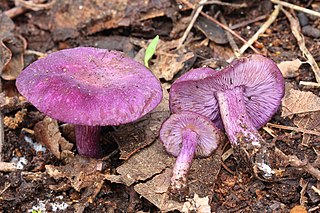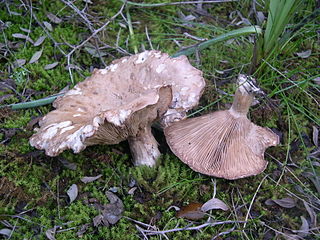Related Research Articles

Vasas SC is a Hungarian sports club based in Budapest.

Agaricus bernardii, commonly called the salt-loving agaricus, or salt-loving mushroom, is an agaric fungus in the family Agaricaceae. The mushroom's thick stem is usually shorter than the diameter of the cap, which ranges from 5–15 centimetres and is convex to flattened. The cap surface is whitish to buff, and can develop scales or warts in age. The gills are initially pink before turning brown when the spores mature. The flesh turns reddish when it is cut or bruised. It resembles species such as A. bitorquis.
Hebeloma ammophilum is a species of mushroom in the family Hymenogastraceae. It was described as new to science in 1978 by the Hungarian mycologist Gábor Bohus.

Amanita regalis, commonly known as the royal fly agaric or the king of Sweden Amanita, is a species of fungus in the family Amanitaceae. A. regalis has a scabby liver-brown cap and a stem which is yellow-ochre at the base, with patches or rings of patches. The fruit bodies somewhat resemble the smaller A. muscaria, which it was formerly regarded as a variety of.
Tricholosporum goniospermum is a species of fungus in the family Tricholomataceae, and the type species of the genus Tricholosporum. First described scientifically by Giacomo Bresadola in 1881 as Tricholoma goniospermum, it was transferred to the genus Tricholosporum, established in 1975 by Mexican mycologist Gaston Guzman. As was pointed out in a 1982 publication by Tim Baroni, the transfer was not valid, "because complete reference to the authors and the original publications of the basionyms was not provided". Baroni made the new combination official in his publication.
Tricholosporum atroviolaceum is a species of fungus in the family Tricholomataceae.
Tricholosporum cossonianum is a species of fungus in the family Tricholomataceae.
Tricholosporum laeteviolaceum is a species of fungus in the family Tricholomataceae. Found in South Africa, it was described as new to science in 1998.
Tricholosporum longicystidiosum is a species of fungus in the family Tricholomataceae. Found in Mexico, it was described as new to science in 1990.

Tricholosporum porphyrophyllum is a species of fungus in the family Tricholomataceae. It is found in Asia.
Tricholosporum pseudosordidum is a species of fungus in the family Tricholomataceae. It is known from Florida.
Tricholosporum subporphyrophyllum is a species of fungus in the family Tricholomataceae. Found in Mexico, the species was described as new to science in 1975 by Mexican mycologist Gaston Guzman.

Tricholosporum tropicale is a species of fungus in the family Tricholomataceae. It is found in Mexico.
Tricholosporum violaceum is a species of fungus in the family Tricholomataceae. Found in Costa Rica, the species was described as new to science in 1996.
Beáta Bohus is a former Hungarian handball player and handball coach. Currently she is the head coach of the Hungarian women's national youth handball team.
Margit Babos was a Hungarian mycologist born on 28 October 1931 in Budapest. She became one of the most widely recognized mycologists in the second half of the 20th century in Eastern Europe, with contributions to mycological research, fungal taxonomy and recording the mycoflora of Hungary.

Agaricus bresadolanus is a species of fungus in the genus Agaricus. Its spores are ellipsoid and lack a germ pore, with dimensions of 5.5–7.5 by 4.0–5.0 µm.
Cortinarius moserianus is an agaric fungus of the genus Cortinarius found in Europe. It was described as new to science in 1970 by the Hungarian mycologist Gábor Bohus, from collections made in Hungary.

Clitopaxillus alexandri is a species of fungus in the family Pseudoclitocybaceae. It has been given the recommended English name of Alexander's funnel. Basidiocarps are agaricoid and resemble those of Clitocybe species. The species is saprotrophic and is mainly known from Europe.
Gábor Bohus (1914–2005) was a Hungarian mycologist born on 4 July 1914 in Budapest.
References
- ↑ "Tricholosporum subgoniospermum Bohus, Vasas & Locsmándi 1999". MycoBank. International Mycological Association. Retrieved 2010-12-16.
- ↑ Bohus G, Vasas G, Locsmándi C (1999). "Two new fungus species from Hungary (Basidiomycetes, Agaricales)". Annales Historico-Naturales Musei Nationalis Hungarici. 91: 37–44.